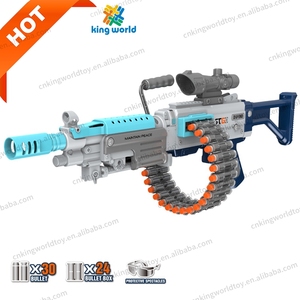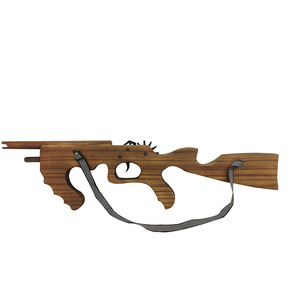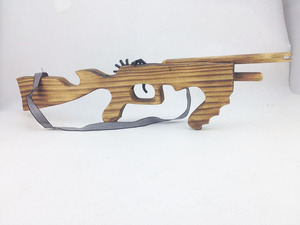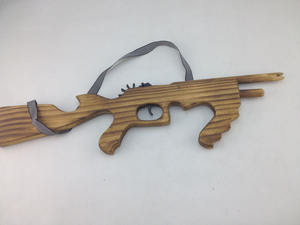(1508 products available)










































































































































































































There are several types of submachine guns, each with its own operational mechanism, design features, and historical significance. Here are the primary types:
Blowback
This is the simplest mechanism, which uses the force of the bullet's explosion to push the bolt backward. It is easy to manufacture and is often found in 9mm submachine guns. Some examples are:
Delayed Blowback
This type of submachine gun is a variation of blowback that involves a system that delays the bolt's opening until the bullet has exited the barrel and the chamber has expanded. This allows the use of more powerful cartridges in a simple, closed-bolt design. Examples include:
Recoil Operated
These submachine guns have a short-recoil operation in which the barrel and bolt move together for a short distance before the bolt separates from the barrel. This allows for a more compact design and higher accuracy. An example is the:
Pneumatic
This type of submachine gun uses air pressure, either from a separate compressed air tank or built-up gas from the fired cartridge, to operate the action. An example includes the:
Hybrid
Some submachine guns combine different types of actions for better performance and reliability. An example of each is the:
When choosing a submachine gun, there are some essential factors that one should consider to ensure the weapon meets their operational needs. The most crucial factor to consider is the intended use of the gun. The intended use will determine the features and characteristics of the firearm required. For example, law enforcement officers may want a compact and lightweight submachine gun that is easy to maneuver in close-quarter situations. On the other hand, military personnel may require a more versatile, reliable, and accurate firearm for various tactical operations.
Another critical factor to consider is the caliber of the submachine gun. The caliber of a gun determines its accuracy, recoil, and stopping power. Therefore, it is essential to choose a caliber compatible with the intended use of the gun. For instance, a 9mm caliber may be suitable for law enforcement officers because it has low recoil and high accuracy. However, a .45 ACP caliber may be better for military personnel because it has more stopping power, even though its recoil is high.
The mechanism of operation is also an essential factor to consider when choosing a submachine gun. The operational mechanism involves how the firearm cycles through the firing, loading, and ejection processes. There are two types of operational mechanisms: blowback and locked breach. A blowback mechanism is simple and cheaper because it has fewer moving parts. However, it works well with low-caliber weapons like 9mm pistols. A locked-breach mechanism is more complex but offers better accuracy and reliability at high firing rates. It uses techniques like the tilting barrel or rotating lock to unlock the chamber during firing. The breach remains locked until the bullet leaves the barrel and the pressure drops to safe levels, allowing the spent cartridge case to be extracted and ejected.
Moreover, one must consider the rate of fire of the submachine gun. The rate of fire refers to the number of rounds that can be fired. A high rate of fire can be advantageous in combat situations where suppressive fire is needed. However, it can also lead to decreased accuracy and increased ammunition consumption. Therefore, it is essential to find a balance between the desired rate of fire and the ability to control it effectively.
Submachine guns are primarily utilized by military and law enforcement entities. The primary use of these firearms is close-quarter combat because they are compact and easy to handle. SMGs can fire multiple rounds quickly, which is essential in situations requiring rapid response. They also have a lower recoil than regular machine guns, making them more accurate for follow-up shots. Additionally, submachine guns can be used in various scenarios, including urban warfare, building clearing, and during riots. Law enforcement officers use them during hostage situations as a last resort; they have to take down suspects who are heavily armed. Submachine guns are also useful for VIP protection details. They can be deployed when the principal's life is in imminent danger and there is no time to prepare.
Submachine guns combine several features to enhance their performance, accuracy, and versatility. One notable feature is the folding or telescopic stock, which is usually adjustable. This allows the firearm to be compacted for easier handling and maneuverability in tight spaces. The adjustable sights, which are also common in SMGs, allow for improved accuracy over varying distances by enabling adjustments to be made for windage and elevation. Many modern submachine guns are fitted with accessory rails, which are known as Picatinny or M-Lok rails. These rails allow the attachment of various accessories, such as tactical lights, fore grips, and optics, enhancing the gun's versatility. Another feature of SMGs is burst fire capability. Some SMGs have a burst fire mode that fires a predetermined number of rounds, usually three, with a single trigger pull. This mode improves ammunition conservation and increases hit probability.
The design of submachine guns is a sophisticated blend of compactness, firepower, and versatility. Submachine guns are designed to fire pistol cartridges, which are the primary reason they are compact and easy to handle. The choice of pistol cartridge calibers, such as 9mm or .45 ACP, balances stopping power and control. The firearm's compact size is another design feature that enhances its maneuverability in close quarters, making it easier to handle. The folding and telescopic stocks are also crucial in their design. They make the firearm compact for storage and transportation. These stocks are collapsible or foldable, allowing the gun to become shorter without compromising the shooter's stability and comfort. Moreover, the design of submachine guns incorporates advanced materials and manufacturing techniques that enhance their durability and reliability. These include high-strength polymers, stainless steel, and corrosion-resistant coatings.
Submachine guns are designed to be safe and of high quality for the users and the surrounding environment. However, it is essential to understand that their safety and quality depend on various factors, including proper handling, maintenance, and adherence to manufacturer guidelines. Here are some key safety considerations for submachine guns.
Keeping the muzzle pointed at a safe direction is essential to avoid unintentional discharge. This means being aware of where the gun is pointed at all times, even when not shooting.
Finger discipline
One should always keep their finger off the trigger and outside the trigger guard until ready to shoot. Also, the finger should placed on the trigger only when intending to fire and should be removed until ready to shoot.
Safety switch
Submachine guns have a safety switch or lever that should be engaged when the firearm is not in use. The safety switch should be in a safe position to prevent accidental discharges.
Proper storage
These firearms should be stored in a locked container or safe when not in use. This ensures they are out of reach of unauthorized users.
Regular maintenance
Submachine guns should be regularly cleaned and maintained to ensure they function correctly. This helps to prevent malfunctions and improves the firearm's lifespan.
Training and education
Proper training and education on handling submachine guns are critical for ensuring safety. This includes understanding the firearm's features, operating procedures, and potential risks. Additionally, training on defensive tactics, marksmanship, and maintenance should be undertaken regularly.
What is the main advantage of a submachine gun?
One of the main advantages of a submachine gun is its compact size. This makes it easy to handle, especially in close-quarter combat situations or when operating in tight spaces. Another advantage is that it is lightweight, making it easier to carry around for long periods.
Are submachine guns legal to own?
Whether or not a person can legally own a submachine gun depends on the country and its respective gun laws. In some countries, civilian ownership of submachine guns is completely banned. In others, it is only allowed with a special permit. It is important to check local laws and regulations before attempting to purchase a submachine gun.
What type of ammunition do submachine guns use?
Submachine guns typically use pistol cartridges. These cartridges are designed to be compact and lightweight, allowing for higher rates of fire and better control in rapid-fire situations. The use of pistol cartridges is one of the factors that differentiate submachine guns from larger and more powerful firearms like assault rifles and personal defense weapons (PDWs).
Can submachine guns be modified?
Yes, submachine guns can be modified. However, the modifications must comply with local laws and regulations. Some common modifications include adding optics, suppressors, and improved triggers.